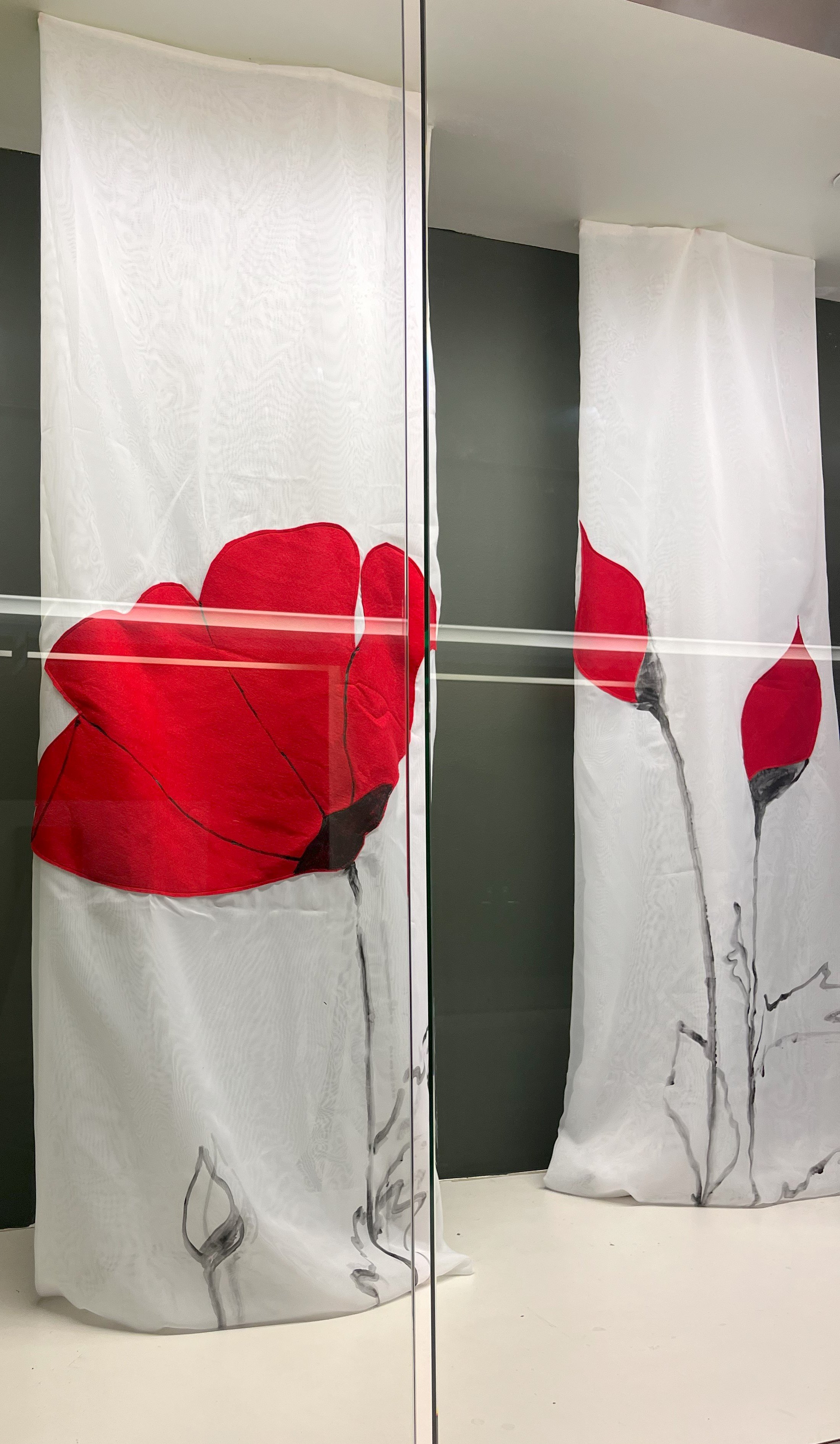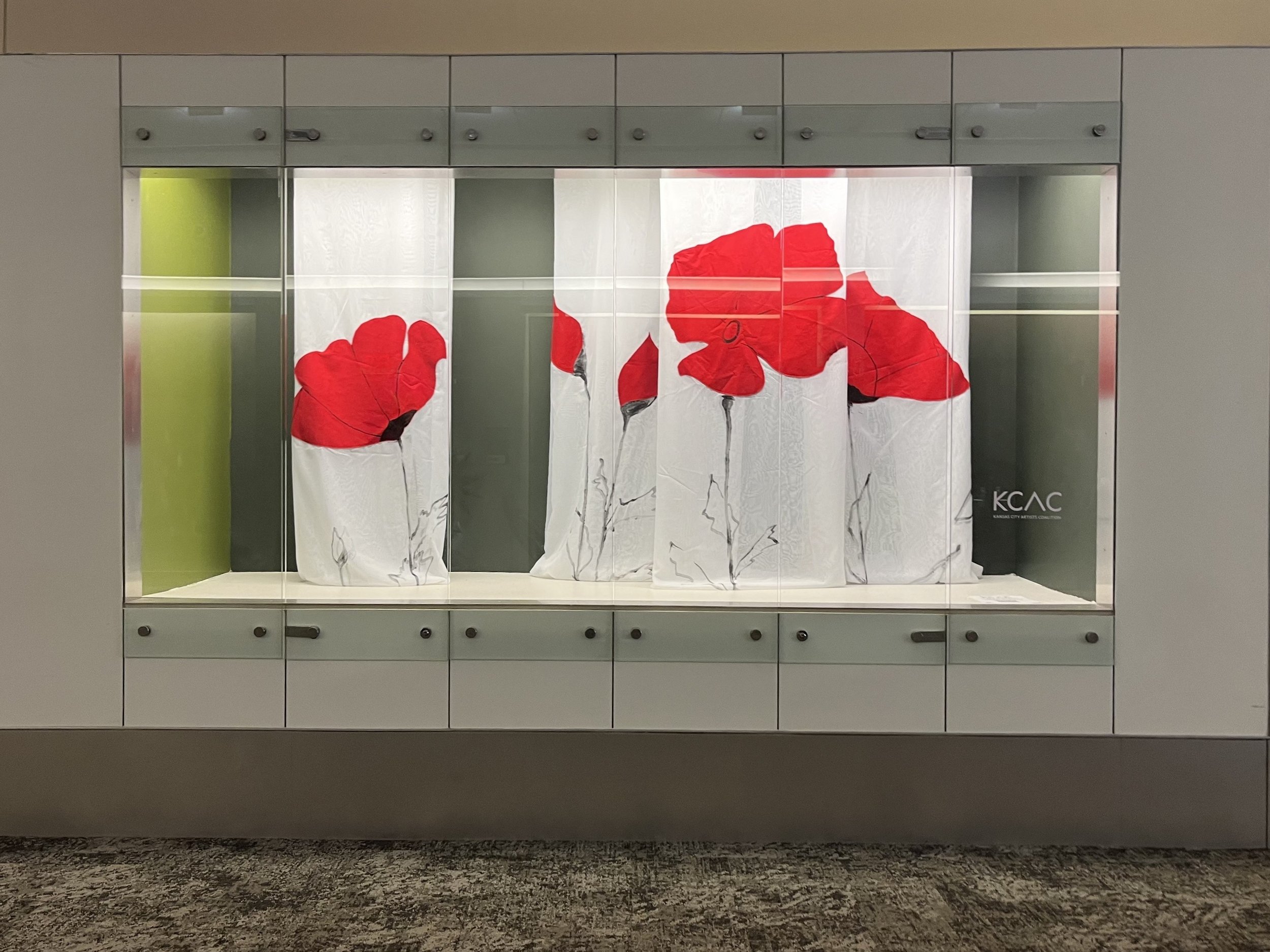 Image 1 of 4
Image 1 of 4

 Image 2 of 4
Image 2 of 4

 Image 3 of 4
Image 3 of 4

 Image 4 of 4
Image 4 of 4





Poppy Silks
Mixed Media
NOT FOR SALE
On View at the Kansas City Convention Center 2100 Lobby
One of the most famous writings to emerge from World War I was John McCrae’s 1915 poem, “In Flanders Fields.” The poem references the fields of poppies that grew on war torn battlefields and is a poignant testament to the human cost of war. Since World War I, people around the world have used the poppy as a symbol of remembrance and sacrifice, as well as a powerful reminder of resilience and hope for the future. At the National WWI Museum and Memorial in Kansas City, Missouri, visitors walk across a glass bridge over a field of poppies. Each of the nine thousand poppies on display represents one thousand combatant deaths, a total of nine million dead.
In Flanders Fields
By John McCrae
In Flanders fields the poppies blow
Between the crosses, row on row,
That mark our place; and in the sky
The larks, still bravely singing, fly
Scarce heard amid the guns below.
We are the Dead. Short days ago
We lived, felt dawn, saw sunset glow,
Loved and were loved, and now we lie,
In Flanders fields.
Take up our quarrel with the foe:
To you from failing hands we throw
The torch; be yours to hold it high.
If ye break faith with us who die
We shall not sleep, though poppies grow
In Flanders fields.
Mixed Media
NOT FOR SALE
On View at the Kansas City Convention Center 2100 Lobby
One of the most famous writings to emerge from World War I was John McCrae’s 1915 poem, “In Flanders Fields.” The poem references the fields of poppies that grew on war torn battlefields and is a poignant testament to the human cost of war. Since World War I, people around the world have used the poppy as a symbol of remembrance and sacrifice, as well as a powerful reminder of resilience and hope for the future. At the National WWI Museum and Memorial in Kansas City, Missouri, visitors walk across a glass bridge over a field of poppies. Each of the nine thousand poppies on display represents one thousand combatant deaths, a total of nine million dead.
In Flanders Fields
By John McCrae
In Flanders fields the poppies blow
Between the crosses, row on row,
That mark our place; and in the sky
The larks, still bravely singing, fly
Scarce heard amid the guns below.
We are the Dead. Short days ago
We lived, felt dawn, saw sunset glow,
Loved and were loved, and now we lie,
In Flanders fields.
Take up our quarrel with the foe:
To you from failing hands we throw
The torch; be yours to hold it high.
If ye break faith with us who die
We shall not sleep, though poppies grow
In Flanders fields.
Mixed Media
NOT FOR SALE
On View at the Kansas City Convention Center 2100 Lobby
One of the most famous writings to emerge from World War I was John McCrae’s 1915 poem, “In Flanders Fields.” The poem references the fields of poppies that grew on war torn battlefields and is a poignant testament to the human cost of war. Since World War I, people around the world have used the poppy as a symbol of remembrance and sacrifice, as well as a powerful reminder of resilience and hope for the future. At the National WWI Museum and Memorial in Kansas City, Missouri, visitors walk across a glass bridge over a field of poppies. Each of the nine thousand poppies on display represents one thousand combatant deaths, a total of nine million dead.
In Flanders Fields
By John McCrae
In Flanders fields the poppies blow
Between the crosses, row on row,
That mark our place; and in the sky
The larks, still bravely singing, fly
Scarce heard amid the guns below.
We are the Dead. Short days ago
We lived, felt dawn, saw sunset glow,
Loved and were loved, and now we lie,
In Flanders fields.
Take up our quarrel with the foe:
To you from failing hands we throw
The torch; be yours to hold it high.
If ye break faith with us who die
We shall not sleep, though poppies grow
In Flanders fields.